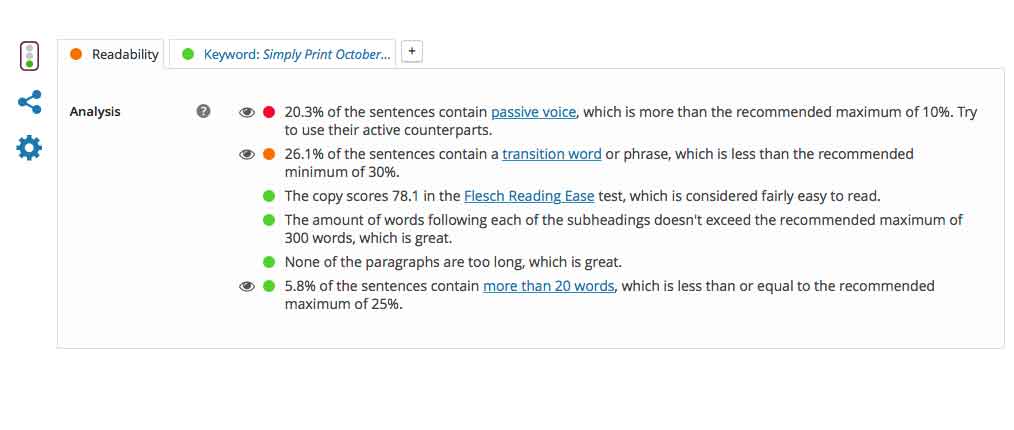Did that sentence make sense?
Have you ever read something and struggled to understand it, but didn’t know why? Did you have to go back and read it again? Chances are you’ve unknowingly become a victim of the phenomenon that is passive voice. We investigate what passive voice is, and why we should avoid using it.
My wife Carey will confirm that I’m what is commonly called a Grammar Nazzi. Some of the grammar on Facebook almost makes my skin crawl. Carey had to politely request that I stop correcting my friends’ grammar on Facebook, as it was very embarrassing for her. I even started correcting non-friends too.”Should of” instead of “should have”, “loose” instead of “lose” and don’t even get me started with people using the wrong “there” word. Their going to the beach with they’re father and there going to have lunch.
I’m becoming quite a fan of writing, even if it’s only about print related matters in our newsletter. I’ve also become a fan of WordPress, the amazing web based software you can use to create a beautiful website, and then edit it at any time. In fact the Simply Print October 2016 Newsletter, and our website were created and edited using WordPress.
I’ve discovered a plugin called Yoast through using WordPress, which shows amateurs like myself how to get the best SEO (search engine optimisation) from posts like these and our website. Without SEO, search engines like Google have little chance of finding us in the massive world that is digital cyberspace. So Yoast has recently educated me on passive voice.
So what is passive voice?
Passive voice occurs in a sentence when we make the object of an action into the subject of the sentence. That is, whoever or whatever is performing the action is not the grammatical subject of the sentence. OK, I know that sounds really confusing. Sorry about that, so let’s put it in a way that is easier to understand.
Why was the road crossed by the chicken?
Doesn’t sound right does it? Of course, the more obvious grammar is “Why did the chicken cross the road?” Who is doing the action in this sentence? The chicken is the one doing the action in this sentence, and that is crossing the subject, the road. But the chicken is not in the spot where you would expect the grammatical subject to be. Instead, the road is the grammatical subject. This puts the actor in the subject position, the position of doing something—the chicken (the actor) crosses the road (the object).
Passive voice can be hidden!
Most examples of passive voice aren’t as easy to see as the chicken crossing the road. Below are some good examples of passive voice, with it’s correct alternative below, called active voice.
At dinner, six shrimp were eaten by Harry. (passive voice)
Harry ate six shrimp at dinner. (active voice)
The savannah is roamed by beautiful giraffes. (passive voice)
Beautiful giraffes roam the savannah. (active voice)
The flat tyre was changed by Sue. (passive voice)
Sue changed the flat tyre. (active voice)
A movie is going to be watched by us tonight. (passive voice)
We are going to watch a movie tonight. (active voice)
The obstacle course was run by me in record time. (passive voice)
I ran the obstacle course in record time. (active voice)
The entire stretch of highway was paved by the crew. (passive voice)
The crew paved the entire stretch of highway. (active voice)
The novel was read by Dad in one day. (passive voice)
Dad read the novel in one day. (active voice)
A scathing review was written by the critic. (passive voice)
The critic wrote a scathing review. (active voice)
You’ll notice that in most cases active voice sentences contain fewer words, but with the same meaning. This makes the sentence much easier to read and comprehend. Passive voice is sometimes hard to see, so Yoast comes to the rescue. Google is definitely NOT a fan of passive voice, and this is a good reason to avoid passive voice on your website.
Does it really matter?
That’s the big question. In the scheme of things, does passive voice really matter? A year or two ago, I would have said no. Now I’m not so sure. With Google constantly moving the goalposts and changing the formula for site ranking, it pays dividends to do a bit more to ensure you stay at the top of the Google pile. The good news is with Yoast, it’s not such a big deal. I can easily correct any highlighted passive voice sentences. Below is a screenshot of what I see with Yoast.

The top line tells me that 20.3% of this newsletter contains passive voice. Unfortunately, there’s not much I can do about that because I deliberately put in a lot of passive voice examples. All I do is click the little eye symbol, and presto, all the nasty critters light up, ready to be destroyed.
As you can see, Yoast has identified a passive voice sentence. So now I can go in and change it, which I’ve done. The passive voice sentence is “Any passive voice sentences are highlighted so I can easily correct it.” I’ve changed it to “I can easily correct any highlighted passive voice sentences.” This puts me (the actor) as the subject of the sentence. I’m using less words, but saying exactly the same thing. Politicians could really learn from this.
Is passive voice a grammatical error?
Definitely not. Passive voice is just a stylistic issue that pertains to clarity—that is, there are times when using passive voice can prevent a reader from understanding what you mean. In fact, there are times when passive voice can’t be avoided, and can be advantageous for getting your point across. Many authors deliberately use passive voice, but they also know when not to use it. The key is knowing the difference, and for me this is still a work in progress.


